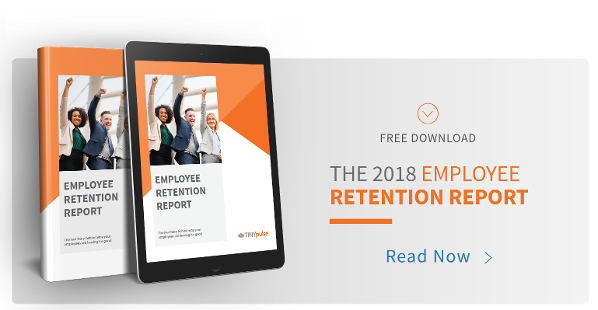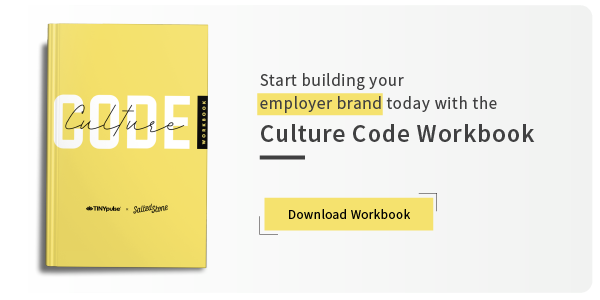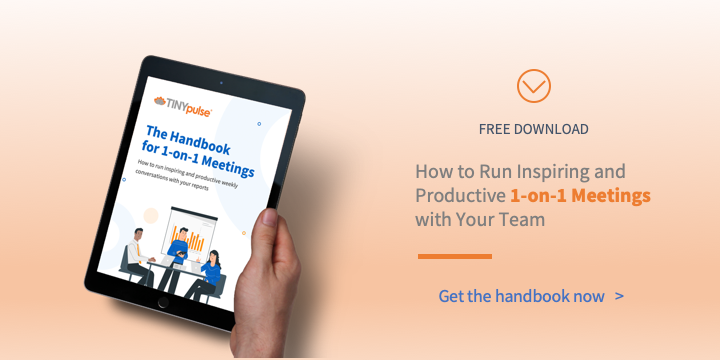How to Create an Inclusive Workplace [Diversity and Inclusion Employee Survey Template Included]

With so much technological disruption going on these days, businesses are consistently adapting their company cultures and processes.
One of the most significant changes among organizations is having a diverse workforce—especially when you consider that almost 67% of job seekers today view it as an important factor when considering employment opportunities.
The same Glassdoor study also revealed that 50% of current employees want their workplace to increase diversity, making diversity essential to creating a healthy work environment with satisfied employees.
FREE DOWNLOAD: EMPLOYEE ENGAGEMENT REPORT 2019
However, simply hiring people from different backgrounds and setting quotas based on things like sexual orientation isn’t enough. While equal opportunity is essential, diversity is about adjusting to constant change and inclusivity.
In this article, we’ll go over the basics of diversity and how you can develop a more inclusive work environment.
What Exactly is Diversity and Inclusion in the Workplace?
Diversity in the workplace refers to how many differences can be found among individuals within an organization. A diverse workplace focuses on merit and ability above everything.
A genuinely diverse team doesn’t only include how people identify themselves but also how others see and perceive them. Diversity can encompass a range of factors and conditions. These usually include diverse backgrounds, different perspectives, cultural background, sexual orientation, gender, age, religion, ethnicity, and even life experiences.
While reducing bias and fostering inclusion is important, diverse companies also focus on intervention.
Each company approaches diversity differently. Some companies focus on monthly diversity and inclusion (D&I) surveys, 1:1 meetings with employees, and other ways to gauge how employees feel. Other companies develop proactive hiring practices centered on diversity.
In any case, diversity and inclusion is as much about the organization as it is about the employees.
Importance and Benefits of Diversity in the Workplace
According to a study by McKinsey & Company, organizations with more diverse top teams were also top financial performers. This is because diversity in the workplace not only builds a better company culture but also increases employee engagement and company performance.
A diverse talent pool ensures that you have multiple perspectives. Different perspectives can help with complex decision-making, problem-solving, and process optimization. As a result, companies tend to see increased profits and improved employee retention when they prioritize diversity.
Furthermore, you are open to more creativity with workplace diversity. For example, hiring millennials can help you develop creative ideas for the modern world. On the other hand, hiring baby boomers can help you understand customer psychology based on decades of experience. At the same time, hiring people from different cultures and backgrounds opens you up to new marketing opportunities.
However, cultural differences are not the only reason you should hire diverse talent.
You will also notice a sudden improvement in innovation and experience a surge of new ideas. It’s also important to provide diversity training to all team members to make up for any issues. As a result, due to the team’s ability to mesh together, build chemistry, and make an impact together, you’ll notice an increase in employee engagement and a reduction in employee turnover.
In the end, your company’s reputation will receive a massive boost and will attract a wider talent pool when you prioritize diversity initiatives. As a result, more job seekers will apply to work at your organization — giving you better hiring results.

How to Develop Workplace Diversity and Boost Employee Engagement
The importance of diversity in the workplace is massive. Still, building diversity may prove to be hard at times. The following are some of the factors you need to keep in mind and address to build diversity in the workplace and boost employee engagement in the process.
Understand the Types of Diversity
It’s crucial to understand the different types of diversity, how they can be factored in, and what each type implicates. Typically, there are visible and invisible diversity traits.
- Visible Diversity Traits: These traits are the ones that are directly observable. They include race, gender, age, body type/size, physical abilities, and physical characteristics.
- Semi-Invisible Traits: These traits may not be instantly observable but can be figured out with a little observation. They include ethnicity, marital status, religion, and socio-economic status.
- Invisible Traits: These traits are unknown until they are communicated in one way or another. They can include sexual orientation, education level, work background, cultural background, beliefs, values, nationality, habits, personality traits, and living conditions, among other things.
Each trait can provide a unique perspective and value that may be beneficial to a company. If you understand precisely what your business needs, what knowledge is required, and what traits are best for a job, you can assess who to hire. At that point, you will be hiring a person for their merit, experience, and knowledge and will be free of any outstanding biases.
Send out a Diversity & Inclusion Survey to Assess Your Current Efforts
Once you have a working understanding of the different types of diversity, you should consider sending out a D&I survey.
A D&I survey can help you understand if your diversity efforts are working and how your employees feel about them. It’s a great way to measure and monitor your organization’s diversity and inclusion efforts, and it also provides insights into whether your employees are satisfied or not.
While each organization may have a slightly different approach to a D&I survey, it’s best to follow a template that’s proven to work.
Employee Survey Questions about Diversity and Inclusion
The following template can be used to deduce your overall D&I efforts. Employees use a scale of 1-5 to rate how much they agree with each statement, with one being the minimum and five being the maximum.
-
This organization is committed to having diverse employees well-distributed throughout the enterprise.
-
The employment/human resource practices of this organization are fairly implemented.
-
This organization invests in the development of all of its employees.
-
This organization is characterized by a non-threatening environment in which people can reveal their “true” selves.
-
Promoting diversity awareness is a priority of this organization.
-
Employees of this organization are valued for who they are as people — not just for the jobs that they fill.
-
This organization has a culture in which employees appreciate the differences that people bring to the workplace.
-
In this organization, everyone’s ideas for how to do things better are given serious consideration.
-
In this organization, employees’ insights are used to rethink or redefine work practices.
-
Top management exercises the belief that problem-solving is improved when input from different roles, ranks, and functions is considered.
It’s also important to add an open-ended qualitative feedback question in the end to give each surveyor a chance to openly portray their thoughts:
- What is one thing our organization can do to increase the inclusion of diverse people and ideas?
The results of the survey can be corroborated with an internal diversity and inclusion audit. Most importantly, such surveys should be regularly completed to make sure companies stay ahead in their efforts.

Develop Training Programs, Policies, and Team-Building Activities
D&I surveys will help you find out if your organization is diversified enough. But, most importantly, they will help you create a more inclusive environment since you will have a better idea of what’s needed in your company.
For example, it may seem like antiracism policies are no longer needed because people are generally more understanding now. However, if you’re in a position of leadership, you have to take every precaution to make sure all your employees are protected.
One way to do that is to enact antiracism and anti-discrimination policies. Such policies address microaggressions, discrimination, and other prohibited actions such as sexual harassment. It’s best to develop the policies with a long-term approach rather than a one-time thing.
Once the policies are in place, you need to focus on training programs and team-building activities. Training programs help coworkers understand each other better and broaden their horizons. After the training programs, you can set up team-building activities to build unity and trust.
Build Trust Among Team Members
It’s crucial for employees to present different opinions. To do that, they need to feel comfortable speaking up. It’s important to encourage acceptance of others’ ideas and make yourself approachable.
If you want to build a successful company, it’s essential for every employee to feel that their input matters. Even simple things such as praising suggestions, implementing ideas, and complimenting can go a long way. You can also thank your team in fun and unique ways; celebrating every single success and win helps build better and more personal relationships with your employees.
Trust is critical to developing workplace diversity because it’s the only way to make sure all employees feel safe and welcome. Many times, people may come to your organization after a bad experience. Showing them how diverse your company is can motivate them and make them feel happier.
You can build trust and help employees settle in your organization by starting with a D&I survey. Once you understand their impression of the company, you can attempt to create a two-way feedback channel. You can help the employees learn and adapt, and they can provide feedback on the organization, practices, and how well they believe they’re acclimating to their role.
Create a Safe Working Environment
Despite diversity measures and anti-discrimination policies, some people still feel unsafe in some work environments. Every employee will have a different definition of what it means to be in a safe working environment. Therefore, it’s best to ask each employee what they need to feel like they’re working in a safe space. It’s critical to let them know that you’re there for them.
Furthermore, you should take all reports on prohibited behavior seriously. You should always follow up on every claim rather than dismissing some if they don’t meet the criteria. There should be strict action against any perpetrators to show every other employee how the organization feels about such behavior.
READ MORE: 14 Employee Survey Questions about Management Effectiveness
However, strict action alone isn’t enough since it’s a reactive approach — not a proactive one. Any such instances should be reason enough to create safer working conditions, using new and improved policies, rules, and even security equipment, such as CCTV cameras, if necessary.
Leading your organization with both a reactive and proactive approach to creating safe working spaces would boost your company’s reputation in various ways. It can lead to positive word of mouth when your employees discuss your organization, better PR, and recognition from your industry. More immediate benefits include a happier, more satisfied, and more motivated workforce.

Focus on Expansive Hiring and Wider Talent Pools
Your talent pool can be severely limited if you implement hiring restrictions, such as considering candidates from select educational institutes, GPA restrictions, and other similar conditions. Such restrictions may not only limit your talent pool but also lead you to miss out on great candidates.
The solution is to significantly expand your network, remove unnecessary restrictions, and have bigger talent pools. For example, if you’re attending the same job fairs to hire new people, you’ll be limited to a particular group of people. At that point, you’ll need to participate in other job fairs for greater exposure.
READ MORE: 30 Questions to Ask New Hires During Employee Onboarding
Similarly, it’s best to remove any unnecessary hiring restrictions you may have (except technical restrictions). For example, setting a GPA restriction can lead you to losing out on many candidates who may have had lower GPAs due to extraneous reasons. The same holds true for college degrees, which are no longer a requirement at many leading organizations.
You can either lower your restrictions or remove them completely. This will significantly increase the number of candidates your HR department has to go through, to be sure. But you’ll be open to a whole new set of candidates.
The bottom line is that you have to be open to multiple talent pools to allow for maximum diversity.
Accountability is the Key to Diversity in the Workplace
One of the most prominent mistakes organizations make is they don’t consider themselves accountable for any anti-diversity actions that occur on their watch. If an employee discriminates against another in the workplace, the company should hold themselves accountable. It not only drives the company to enact more thorough anti-discrimination and diversity measures, but also helps create trust.
Furthermore, if your organization lacks diversity, you shouldn’t try to simply hire different people in an effort to increase diversity. The right way is to be accountable and to share your plans for diversity. Being transparent is imperative, and sharing your progress helps employees feel safer and happier.
Increasing Diversity and Inclusion in the Workplace
It’s not easy to create a diverse workplace — especially if you’re starting suddenly or if you have a small number of employees. However, diversity is based on both invisible and visible traits. Therefore, it’s always possible to create a more inclusive and diverse workplace.
If you’re wondering whether your team is diverse enough, you can start by carrying out employee satisfaction surveys. They will provide immediate insights into how your employees feel about the workplace. It can then help you deploy the appropriate diversity and inclusion measures.
However, your focus should be on conducting a Diversity & Inclusion survey to properly measure and monitor your diversity and inclusion efforts at all times. Doing so would ensure you’re always working towards building a more inclusive environment.
Business success is the result of innovation, and innovation is born at the intersection of challenges, experiences, and ideas from a diverse workforce.
Here’s to creating a diverse and inclusive workforce — and enjoying better business outcomes because of it.
Share this
You May Also Like
These Related Stories

5 More Insightful TED Talks about Team Culture

How The Sexes Differ On Diversity, Equity, & Inclusion





.png?width=534&height=632&name=blog%20ad%20(1).png)
